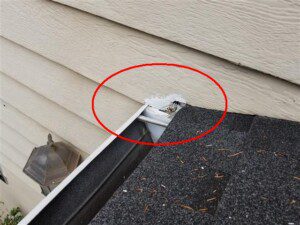
Roof flashing is often made from sheet metal or plastic pieces that are shaped with angles and edges that control water flow as the water runs down and off of the roof. In some cases, roof flashing can be made from waterproof sheet membranes in areas where sheet metal is not a viable option, such as at large transitions, and in areas where metal may be more susceptible to corrosion. Current building standards requires roof flashing at roof edges, around vents, plumbing, chimney and skylight penetrations. Roof flashing is also required at open valleys where two roof planes meet.
Kick out flashing is a specific type of flashing that is installed where roof edges meet the side of a building. Since these areas often experience large amounts of water flow, having kick out flashing installed can allow water to be deflected into the rain gutters and away from the home. Lack of kick out flashing, or improperly installed / sized kick out flashing could result in water intrusion into wall structures.
In some cases, if a home experiences long term damage due to the lack of proper kick out flashing, other repairs may be needed, such as siding, structural, insulation, or mold remediation repairs. The cost for these repairs could be substantial, which is why kick out flashing is a very important building component that helps to prevent extensive damage.
When a home inspector indicates issues with kick out flashings in a home inspection report, you should have a licensed contractor further evaluate the home and provide a quote for repairs. With this information, home buyers can then make an informed decision regarding the next steps in their home buying process.
